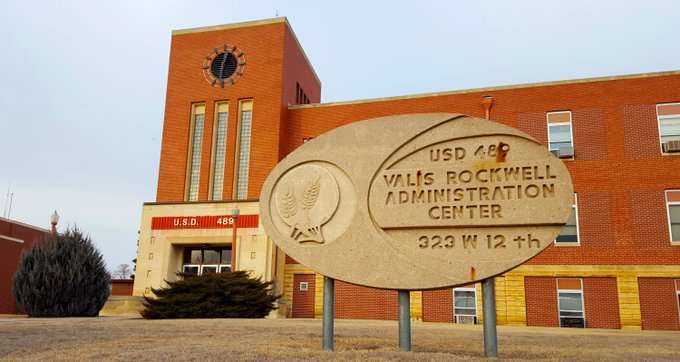
By CRISTINA JANNEY
Hays Post
A recent Kansas Association of School Boards study recognized Hays USD 489 as a high-performing district.
Mark Tallman, researcher, gave a presentation last week to the Hays school board on his findings.
The research identified school districts in the state that were outperforming their expected scores on state tests. Some challenges the research considered were the number of students facing poverty and special education students in districts.
Tallman focused on three aspects of the state board of education accreditation standards, including state assessment scores, graduation rate and post-secondary success.
Post-secondary success, as defined by the state board, means the number of students in post-secondary education who have achieved a degree or certificate two years after graduation. It does not count students who enter the workforce directly or join the military.

Ninety percent of jobs are expected to require a high school diploma. Seventy to 75% of jobs are expected to require more than a high school diploma, Tallman said.
On average, salary tends to increase with education. The average salary of a non-high school graduate is $32,838, and the average salary of a person with a bachelor's degree is $58,583.
Education level has an inverse relationship to poverty level. Twenty-four percent of workers without a high school education are in poverty, compared to 4.1% with bachelor's degrees.

States with higher per capita education levels have higher per capita incomes. Kansas currently ranks somewhere in the middle.
Tallman suggested if Kansas could increase its four-year college completion rate from 35 to 39% statewide, incomes would increase by $23.2 billion per year, which would mean about a 4.4% increase in personal income.
He suggested that would result in an increase in income tax revenue for the state.
"At that rate, Kansas schools would receive over $1 billion in additional funding or over $2,100 per unweighted pupil," Tallman said.
"It's easy to say who's best on all of those, but there's a complication," Tallman said. "We know there are significant differences based on factors the school can't control."
Tallman also looked at the percentage of students who received free or reduced-cost lunch and had disabilities.
He also compared districts with similar enrollments. Hays fell into a tier with schools with enrollments of between 1,600 and 10,000 students and was compared with 49 other public schools. Hays has an enrollment of about 3,100 students.
Tallman said the more higher need, low-income, disabled students you have, the worse your results tend to be. He said getting higher results is more difficult if you have more challenging students, but any district can show improvement over time.
Tallman said 11 of the 50 school districts in Hays' tier performed better than expected.
When performance was adjusted for poverty and disability weighting, the Hays district ranked third in its enrollment tier.

Tallman spoke to district leaders to determine what the district staff was doing to achieve success. Despite the districts' differences, he found many similarities. Hays was doing all of the things he highlighted in his report, Tallman said.

"It is not necessary that these districts are doing different things, but they are doing them with a higher degree of commitment," Tallman said.
The successful districts stressed the use of data and accepted the validity of that data.
They did not say their only goal was to raise test scores but said increasing scores was among their goals, Tallman said. The districts dedicated staff and time to analyzing that data and used that information to make decisions.
"If you don't put your work into independent context ... if you aren't looking at how you compare to other districts, how you compare over time, how you compare to state standards, then you don't really know how you're doing based just on yourself," Tallman said.

"If a student is not getting this math concept at this level, then we do something about this student," Tallman said.
The recognized districts also said they were doing more to help students address mental health and personal challenges. Tallman called this "High Love and High Expectations."
He said lowering expectations of at-risk students does not help them.
"Not easier routes, but more routes to success," he said.
Engaging students and their parents was a high priority to the districts that were recognized as high performers. That included career pathways, individual plans of study, clubs and activities, a larger voice for students, engagement with parents and the community, and emphasis on early childhood education.
"If all that we do is stand out there and demand that they learn," Tallman said, "that doesn't work."
Tallman said successful districts credit their local school board for being supportive but balanced oversight with letting educators do their jobs.
Teachers in these districts also said they supported their administrators and felt valued. He said there was a strong sense of collaboration and teamwork.
Because of high morale, these districts tended to be less affected by teacher shortages because they were able to retain teachers, Tallman said.
"I think your district has a lot to be proud of. I think your community has a lot to be proud of," Tallman said.






